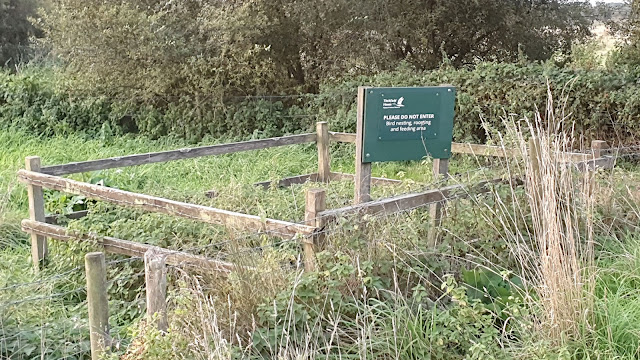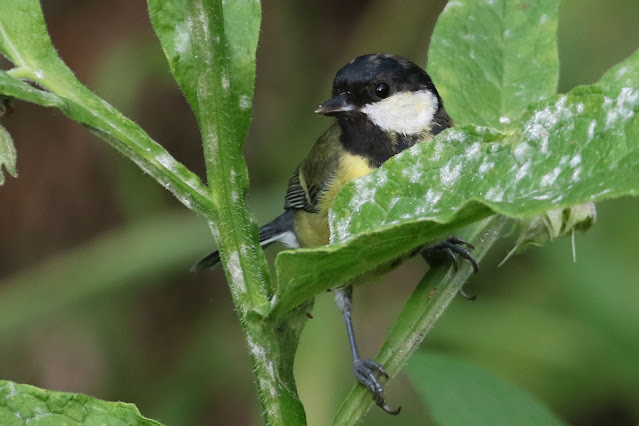Another Saturday morning, another glorious sun rise, this time at the start of the Titchfield Canal Path. I must admit to not being too pleased to see this one, I had hoped the forecast cloud would have hidden it today and the fresh north east breeze that was with had died down a little. It wasn't to be and Ian an my hopes of seeing the Barn Owl return to roost were pretty much reduced to zero.
With the clear skies the chances of migrants too along the path were also very much reduced and this proved to be the case. Nevertheless it was a lovely walk at a time of day when we were the only ones about. I had to stop and photograph this sign, surely this must be one of the smallest reserves in the country!
A little further along where the canal opens up we disturbed a Kingfisher that flew off across the meadow, disappearing into the reeds
The wispy nature of the cloud that was present did restrict a lot of the glaring sunshine, so scanning the meadows was not difficult, the only problem was that there was nothing to see. Stopping at one of the many gates we did catch this dog fox before it slipped away into the hedgerow.
At the next stop w had six Snipe fly over, here were two of the second three, I was more prepared for these than the first three.
Reaching the end of the path we walked around the chalets, good numbers of Swallows and House Martins were moving, heading south east over our heads. In the scrub close to the cliff path there was a lot of movement involving fighting Robins, several fly catching warblers with a couple of Willow Warblers and a single Whitethroat, but the Chiffchaff were the more showy. perching up on the bramble branches.
In the bramble and bushes closer to us there were a couple of Sedge Warbler and a single Cetti's Warbler. We stood watching these and distant movement in the bushes beyond which looked like Chiffchaff and Willow Warblers once again.
The walk back along the canal path was about as interesting as the walk down, I only stopped for a Great Tit that was interested in the cumfrey.
As it was Ian's birthday he was off to open his presents, I had already pre-booked entry into the reserve so I headed back to the sea wall. I spent some time on the bridge while I waited for my time slot in the hope the Kingfisher might appear, it didn't.
Once booked in I headed back to the west entrance and the Meon Shore Hide. The water level was even lower with the mus that was wet two weeks ago very dry now. From the hide I could see a few Dunlin, Redshank and a large roost of Black-tailed Godwits and Oystercatchers. No sign of any of the interesting waders from the last visit. On one of the island a single Wigeon was at roost. Interesting today, but in a few weeks they will be common place.
I was here in the hope that the reported Pectoral Sandpiper in the week would turn up. I had missed one last weekend at Farlington, so hoped Titchfield would redeem that. It was going to be a case of sit it out, wait and hope while checking all the waders that moved.
A single Redshank came close to the hide.
I went awhile without anything of interest appearing. Teal fed all around and every so often a Dunlin would fly across but never came close. The to my right I noticed some movement and a Snipe appeared from the reeds moving cautiously through the mud and reed stalks probing as it went.
It is a well camouflaged bird and is usually shy and
conceals itself close to ground vegetation and flushes only when approached
closely. Seeing one like this in close up and in the open is a real treat. The body is mottled brown with straw-yellow
stripes on top and pale underneath. They have a dark stripe through the eye,
with light stripes above and below it. The wings are pointed. They have short greenish-grey legs and a very
long straight dark bill.
Snipe search for invertebrates in the mud with a
"sewing-machine" action of their long bills. The sensitivity of the
bill is caused by filaments belonging to the fifth pair of nerves, which run
almost to the tip and open immediately under the soft cuticle in a series of
cells; a like adaptation is found in sandpipers; they give this portion of
the surface of the premaxillaries a honeycomb-like appearance: with
these filaments the bird can sense its food in the mud without seeing it. They mainly eat insects and earthworms, also
some plant material.
It’s not just avian predators but also man, the Snipe is
unfortunately termed a game bird and if and when the snipe flies, hunters have
difficulty wing-shooting due to the bird's erratic flight pattern. The
difficulties involved in hunting snipes gave rise to the term sniper,
meaning a hunter highly skilled in marksmanship and camouflaging,
which later evolved to mean a sharpshooter or someone who shoots from
a concealed location.
There were some distractions while watching the Snipe, a couple of Pied Wagtail fighting over the insects on the dried mud.
Three Knot flew in, probably as a result of the rising tide in the Solent, they joined the group of Black-tailed Godwits
One or two Black-tailed Godwits would come close, but never quite close enough, then a single bird that was still showing some of the reddish summer plumage flew and round and dropped down on the mud in front of me. A lovely landing.
With a north east fresh breeze and all the windows in the hide open it was very cold, time was also moving on and I was getting hungry. I decided to take one more Snipe photograph before I moved on.
I decided to call time on the day, it was clear that the Pectoral Sandpiper was not going to turn up, and in the afternoon one was reported from Pennington, probably the Haven bird moving away over night. Not one of our better days but some really great shots of wader that tries its hardest to avoid being see. Every day is a good day when you are watching wildlife. All I can say is I hope new imposed regulations to tackle the virus don't stop me from continuing to do so.











































No comments:
Post a Comment